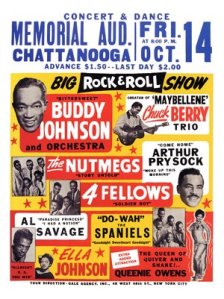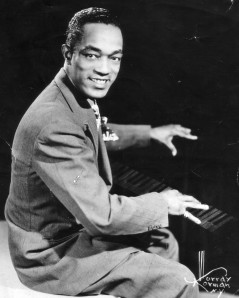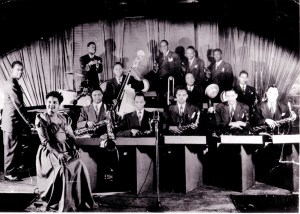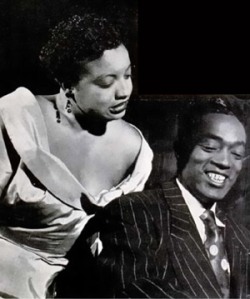A favorite game of some music fans is picking the first rock ‘n’ roll record. Roy Brown’s 1947 record of “Good Rockin’ Tonight” is often cited. Others trace rock’s origins back to pianist Pinetop Smith’s 1928 classic, “Pinetop’s Boogie Woogie.” The two decades between those records coincide with the Big Band Era and the nascent sounds of rock ‘n’ roll are also heard in records by Count Basie, Benny Goodman, Lionel Hampton and others. But no other big band leader captured the transition of swing to rock ‘n’ roll quite like pianist/arranger Buddy Johnson.
This week on SDPB Radio’s Big Band Spotlight, we’re featuring the dynamic, foot stompin’ music of Buddy Johnson and his Orchestra. Johnson was an immensely successful bandleader with a long career lasting from the Swing Era right up through the dawn of the Beatles. His roaring orchestra packed dance halls from New York to Kansas City to Los Angeles with a lively combination of bluesy ballads, novelty numbers and explosive dance numbers. Yet if you page through big band reference books, you’ll find little, if any, mention of him. Even George T. Simon’s classic The Big Bands completely passes him by. (Buddy Johnson shouldn’t be confused with saxophonist/arranger Budd Johnson.)
Johnson’s lack of recognition is mostly due to the fact that his heyday came at a time when the U.S. was still racially divided. His popularity was mainly limited to black audiences, especially at Harlem’s famed Savoy Ballroom and throughout the South on the so-called “Chitlin’ Circuit.” His records weren’t played on mainstream pop stations so he was mostly unknown to white listeners.
Johnson was born in South Carolina in 1915 and at the tender age of four was already learning the piano. By the time he reached high school he was writing musical revues for school and church groups. Johnson moved to New York City in 1938 to establish himself as a professional musician and quickly landed a job as pianist with a traveling Cotton Club show, which played in Europe just as World War Two was breaking out.
Back in the U.S., Johnson was performing with a small combo in a Greenwich Village Club where he was noticed by a talent scout for Decca Records, which had a rich roster of African-American artists. Decca signed him up and Johnson made his first records for the label with a small combo in the fall of 1939.
By 1944 Johnson was leading a full big band. It was a boisterous, brassy unit with a rhythm dominated by a strong back beat that became increasingly heavy as the years progressed. Along with Johnson’s talent as an arranger and composer, a major factor in the band’s success was younger sister Ella. She joined big brother Buddy in New York while still a teenager and started recording with his band in 1941. She sang ballads and blues with a uniquely terse and straightforward style completely lacking in histrionics. Her singing served as a nice contrast to the shouting riffs, honking tenor saxes and hard-hitting rhythms of the band.
Johnson built most of his arrangements on the blues. He said there was a touch of his home South Carolina in all of them; he always kept his music simple, understandable and danceable. That was the key to Johnson’s survival at a time when other big band leaders were throwing in the towel. Many big bands of the mid-to-late 40s, both white and black, had moved in directions that were too complex and impossible to dance to. They were creating art and concert music and not something people could move their feet to when out on a Saturday night.
Johnson might have been keeping his music simple, but it wasn’t simple-minded. His charts were rich with thick textures and harmonies with occasional traces of modern jazz. There was always enough variety to keep things interesting, even within a limited blues framework.
Johnson’s most famous composition is the ballad “Since I Fell for You.” Ironically, his original 1946 record of the song featuring Ella’s vocal wasn’t a big seller. It didn’t become a big pop hit until 1963 when Lenny Welch’s record of the song reached number four.
In 1954 Johnson became a part of the burgeoning rock ‘n’ roll scene when he joined legendary disc jockey Alan Freed’s tour packages in which his band served as the primary accompaniment for the show’s singing acts. He was now recording for the Mercury label and while his music wasn’t that much different from what it had been a decade earlier, the beat was much heavier, the riffs simpler and honking tenor saxophone solos dominated.
 Johnson’s late Mercury records, especially December 1955’s “Doot Doot Dow,” demonstrate the dead end of big band rock ‘n’ roll. Here Buddy Johnson is moving from the simple to the simple-minded. The title is just as insipid as the monotonous, childish melody. Johnson is stuck playing repetitive piano triplets while the saxophones honk away on a tiresome two-note riff. (Admittedly the record improves once the band moves past the main riff.) All those horns just aren’t needed when playing such basic music and the musicians must have been bored to tears.
Johnson’s late Mercury records, especially December 1955’s “Doot Doot Dow,” demonstrate the dead end of big band rock ‘n’ roll. Here Buddy Johnson is moving from the simple to the simple-minded. The title is just as insipid as the monotonous, childish melody. Johnson is stuck playing repetitive piano triplets while the saxophones honk away on a tiresome two-note riff. (Admittedly the record improves once the band moves past the main riff.) All those horns just aren’t needed when playing such basic music and the musicians must have been bored to tears.
Once Elvis Presley came along, big bands and even honking rhythm and blues combos were out, and stripped-down, guitar-based groups were in. Buddy Johnson gave up his orchestra in the late 50s and worked with smaller bands. He made a few more records before recording his last in 1964. After that both Buddy and his sister Ella retired from the music business and instead devoted their talents to the church. Buddy Johnson died in 1977 at the age of 62 after a long battle with cancer. Ella lived to the age of 80 and died in 2004.
Buddy Johnson’s music might be overlooked by big band fans and critics, but when it came to explosive, high energy party music, there were few bands that could match the Buddy Johnson Orchestra. No, it wasn’t deathless art, but not everything has to be. Sometimes, you just wanna’ dance.



